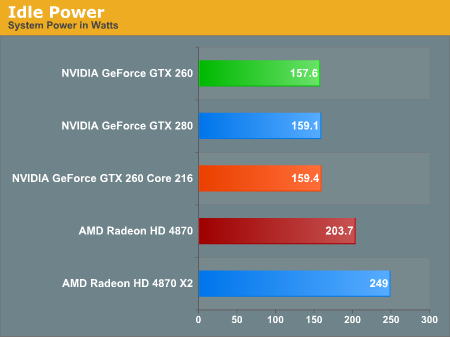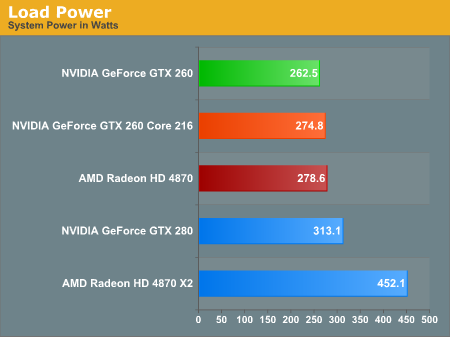NVIDIA GeForce GTX 260 Core 216: Competition for the 4870
by Anand Lal Shimpi & Derek Wilson on September 16, 2008 12:00 AM EST- Posted in
- GPUs
Power Consumption
While idle power is roughly the same as the GTX 260, load power does increase a little bit. Keep in mind that we did underclock an EVGA Superclocked Edition of this card for these tests. If EVGA set voltages higher on this part than they would on stock clocked hardware, we might be seeing an increase in power consumption due to this.
What we can say is that we think this is a good picture of worst case power consumption increase from a GTX 260 to a GTX 260 core 216. This is not a bad thing, as the GTX 260 core 216 does draw less power than the Radeon 4870 under load and at idle.












65 Comments
View All Comments
araczynski - Wednesday, September 17, 2008 - link
it'll be quite a long while before nvidia competes again in the bank/$ game. i also got in on the two 4850's for under 300 deals when they first came out...nvidia needs to go back to the drawing board on their current chipset offerings.
Jedi2155 - Tuesday, September 16, 2008 - link
Why is that in almost every single benchmark I've seen here with Crysis, its always without AA?I think that is a important component to measure as it puts a further strain on the memory bandwidth and shows potential weaknesses of an architecture. Crysis as i've seen on some other sites seems to show the limits of a 512 MB frame buffer on the 4870 versus the GTX 260's, and I would like it if Anandtech could confirm this :).
Casper42 - Tuesday, September 16, 2008 - link
I had heard that the 55nm version of the 260 and 280 was going to be called the 270 and 290 which would explain why they decided not to use 270.Overall though I agree that they need to come up with a better naming convention. Do the same Generation/Family/Varient thing as AMD or else go back to the old naming convention and make the number tell you how many SP Cores and type of memory used and stuff, and then do the GS/GT/GTX on the end to signify the clock speed level of the card within the family.
Here, nVidia, i will do it for you.
The current cards are now named:
??? = whatever the hell you like. nVCore or GeForce or CoreForce or whatever marketing name you decide to spend way too much money thinking up.
??? 208 GTX
??? 209 GTX
??? 210 GTX
Your 55nm replacements will be the:
??? 308/309/310 GTX (Assuming they use the same memory config or if you switch to a narrower width on the memory bus, it better be GDDR5 then)
2 is your family code for current gen and 3 will be for 55nm
08-10 = number of SP Cores
GTX = high end Card
So a mid range card might be something like the ??? 206 GT
And a Cheap card could be the ??? 203 GS
Dont even have to change your internal design of the SP Cores.
And if you Tick/Tock like Intel, then the next generation after this one can
Casper42 - Tuesday, September 16, 2008 - link
Next generation after 55nm can be the 4 series and then the 45nm variant of that can be the 5 series and you now have a naming convention for the next 4 years at least.pauldovi - Tuesday, September 16, 2008 - link
Why would you have one FPS at 60.9 and the other at 61? It should either be 61 and 61 or 60.9 and 61.0. If .1 is within the margin of error you should not report FPS to this accuracy.Learn a little about significant digits!
AnnonymousCoward - Wednesday, September 17, 2008 - link
"!?!?"? Is it that big of a deal? I actually prefer dropping the ".0" for the sake of simplicity, and I'm an engineer.strikeback03 - Wednesday, September 17, 2008 - link
Could be Excel automatically throwing away trailing zeros.drebo - Tuesday, September 16, 2008 - link
The main thing keeping me from upgrading my 7900GT right now is how damn many video cards there are available. I can't tell which is better, the 9600GT, 9600GSO, 9800GT, 8800GT, etc, etc, etc, as they're all within about a $40 spread and all seem to be the same damn card.It's frustrating. I wish nVidia would stop doing this. Choose a set of price points and release four to six cards for those price points. High end ($300+), mid range ($200-$300), low end ($100-$200), multimedia ($50-100), extreme low end ($30). We don't need a card spaced every $5 through the spectrum. $50 price differences should more than suffice.
aeternitas - Wednesday, September 17, 2008 - link
Its not really that bad. All you need to do is a little reaserch about each card and you can put them in a easy list. But yes, they do need to work on nameing..Also, they come out with a handfull of cards every 9-18 months, you cant blame them for places still selling last 2 generation cards and you getting confused! Todays highend will be tomarrows midrage, and guess what? The prices will be similer. Its your job to investigate your investment.
The power... IS YOURS!
MrSpadge - Tuesday, September 16, 2008 - link
Just get a 4850 :)(.. seriously saying this while having bought a 9800GTX+ a few weeks ago and really like it)
MrS